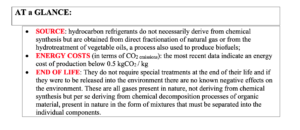Hydrocarbons (HC) are among the very low-GWP refrigerants available on the market today, able to ensure high energy efficiency in all applications in which they are used. They belong to the group of the so-called natural refrigerants because they consist of molecules not necessarily derived from chemical synthesis but that are naturally occurring in nature and were part of our atmosphere since the beginning of time. Hence the reason why, once accidentally released into the environment, they do not give rise to unwanted or unexpected reactions with other molecules in the ecosystem and have no harmful effects on the environment: these are molecules that the ecosystem “knows well”.
Hydrocarbons are not a new kind of refrigerants. As Daniel Colbourne writes in the precious document entitled “History of Flammable Refrigerants”, also available at www.ior.org.uk , these molecules have a long history and tradition, having been used as refrigerants since the dawn of refrigeration.
Today their diffusion is experiencing interesting developments, precisely because of their characteristics of sustainability and efficiency during their life cycle. But by analyzing the production processes and the energy costs associated with them, the production and the disposal processes stand out for their relevance in lowering the overall emissions of these gases. These natural refrigerants seem to be then more sustainable, from the cradle to the grave. We met with with Daniel Colbourne, specialist in environmental, safety and performance issues related to flammable refrigerants, to enquire about these gases.
What are the methods of producing hydrocarbon refrigerants today?
It depends on the refrigerant. Saturated hydrocarbons – ethane (R170), propane (R290), isobutane R600a, butane (R600), pentane (R601), etc. – generally derive from natural gas. Natural gas consists mainly of methane (R50), typically in a fraction of 80-90% and the remainder includes other HC and other gases. This mixture is split – usually by fractionation – and returns pure hydrocarbons. These hydrocarbons are mainly used either in chemical production processes or as fuels (e.g. as LPG). Only a very small fraction of them is used as a refrigerant. As for propene, although most of it is obtained through a propane cracking process in refineries, it is sometimes found as a residual component of natural gas as well as a product of the ripening process of some fruits. Today there are also other methods to produce HCs, for example by hydrotreating vegetable oils (HVO) that give bio-propane or other bio-HCs. Since this process uses biomass it is probably preferable to starting from fossil material. It is not known to me if these sources are actually used for refrigerant production today but they are technically feasible.
Are there any estimates of what fraction of HC produced is used as a refrigerant?
A very, very small fraction. If we assume that the consumption of HC refrigerants is about a few tens of tons per year, whereas the hydrocarbon market is about 400-500 million tons per year, the fraction is much less than 1%.
With these production processes, in principle, every country that has a refinery can produce these refrigerants, without having to pay any usage fees or have restrictions due to patents?
Correct. In this sense, the use of pure HC refrigerants in a conventional refrigeration system is not controlled. There have been several patents over the years that have covered HC blends but as far as I know they are insignificant. There are studies from decades before these patents where mixed HCs were used; therefore, it would be difficult to argue that a given blend is not an obvious development. Likewise, there are numerous (hundreds) of patents covering HCs in certain types of systems and equipment. But I am not aware of anyone unable to produce any specific piece of RACHP equipment using HC due to a patent infringement.

Natural, yes or no?
Sometimes we hear claims that these refrigerants cannot be considered natural or called such because they – like ammonia and CO2 – are industrially produced. What would you answer to this statement?
It depends on how natural is defined. Some classify a coolant that derives from natural sources as natural. Others like a substance that already exists in nature. Generally, the argument is that if a substance has been part of natural cycles and processes for millions of years in the history of the earth, then using it and putting it into the ecosystem probably has no negative impact on the environment. Of course, CO2 meets this criterion but now we have a bit of a problem with this molecule because we have emitted too much of it. However, if ammonia, CO2 and HC were unintentionally emitted into the ecosystem in the same quantities as CFCs, HCFCs and HFCs their impact on the climate would be negligible because their GWP is very low whereas the other molecules have GWP of hundreds or thousands. times higher.
Energy costs
Are there any calculations of the energy consumption involved in the production of HC?
Yes, there is now a lot of data on this. Expressing energy consumption (and associated emissions from energy use and emissions during processing) in terms of kgCO 2 -eq per kg of HC, HCs (including R1270) are generally responsible for approximately 0, 5 – 1 kg of CO 2 per kg of HC. There is some data in the table from Energy Policy of 2011 (see below), although these are quite outdated. More recent values for HC give emission factors lower than 0.5 kgCO 2 / kg. In any case, the value varies according to the characteristics and efficiency of the refinery plant, the quality of natural gas, etc. As far as “bio” HCs are concerned, the production emissions are about the same as those of “fossil” HCs, but the “indirect” GWP (i.e., from decomposition products of the gas) are negated because the carbon has originated from biomass. By comparison, the values for fluorinated refrigerants are much higher and span a wider range. And of course, the values published by refrigerant manufacturers are much lower than those of independent sources. Emissions are very sensitive depending on the individual production facility, as some may emit many intermediate fluorinated species with very high GWP (e.g., R23). The emissions of some unsaturated HFCs (HFOs) are even higher – about double – than conventional HFCs due to the more energy-intensive manufacturing process. Naturally, as manufacturers optimize their production processes, production-related emissions are likely to decrease. However, since HCs are used as raw materials to produce fluorocarbons, their production energy and emissions must be substantially lower than those of the fluorocarbons they are used to produce.
End of life
What happens with HC refrigerants when a plant or machine reaches the end of its life? Do they need special treatment?
As usual, it depends. For appliances that fall under the WEEE directive, which are collected and properly treated, all the refrigerant is extracted and disposed of correctly. Usually this takes place in an incineration plant. For larger machines (for quantities of around kilograms or more), the refrigerant should be recovered and reused, as is the case with other refrigerants. It is likely that with systems of intermediate size, HCs are often discharged into the atmosphere. As usual, the practice probably depends on the company, the individual, the flammability risk and local regulations. In any case, in most cases they do not require “special treatments” from an environmental point of view; by comparison, about one million tons of HC are emitted from aerosol cans every year, while emissions of HC refrigerants are likely to be in the order of a few hundred tons. Not that this makes them more acceptable, but it lessens their impact.
The “big” issue
Hydrocarbons are flammable, but considering that in modern life there are so many flammable materials that we use on a daily basis and that we are probably entering the age of hydrogen, doesn’t this topic seem a little overrated? In other words: where does unjustified fear end and where does the risk begin?

There are some things to consider. First, a general risk perspective: there is a background risk of fire with any RACHP equipment, due to the use of electricity. In some countries, there are comprehensive statistics showing that electrical fires of RACHP equipment (which often lead to fires in buildings) occur in about 1 in 100,000 units per year (regardless of the type of refrigerant, flammable or non-flammable). The additional risk of fire from igniting leaking HCs during “normal operation”, assuming safety rules have been followed, is 1 in 1,000,000,000 – 1,000,000, depending on the type of equipment, location installation features, design features, etc. Hence, the additional risk from using flammable refrigerant is normally a very small fraction of the background risk, especially if the equipment is well designed. When we compare the risk of fire of a HC heat pump with that of gas appliances (cookers, heating boilers, etc.) which present a fire risk of about 1 in 10,000 per year it is even more evident that the incremental risk to the flammable refrigerant is insignificant. When quantifying the additional risk that appears to be in the order of fractions of a percentage of the background fire risk, these values would be considered negligible, i.e., the expected rate of incidence is so small as to have little practical significance (in relation to other daily risks). It could be argued that if an electrical fire occurs, the presence of HCs in the system could make the fire more serious. However, in tests it is observed that this is not quite the case. Considering the numbers of combustible materials (foams, plastics, oils, etc.) in most equipment, the difference in energy release in the event of a fire is almost indistinguishable between flammable and non-flammable refrigerants. Furthermore, the combustion of HCs produces far fewer toxic decomposition products than the combustion of HFCs. Also to stress is that, probably due to the need to avoid electrical component sparks with HC, safer and more reliable components are selected, thus leading to fewer background electrical fires. Graph 1 shows the frequency of fires caused by household refrigerators in the UK over the period they transitioned from R134a to R600a. Most (if not all) causes are electrical fires. Of course, it would not be appropriate to say that the reduction in fires is due to the introduction of R600a – since the quality of the design of the appliances and electrical systems would have improved over time – but it is clear that the incidence of fires has not increased. It’s worth stressing that some circumstances could lead to higher firing rates than expected, such as when technicians and / or manufacturers don’t do things correctly and as a result could potentially lead to much higher firing rates, injury, damage and so on. For example, a small oversight in the design of a mass-produced product could result in a much higher incidence of ignition events. This is more likely with some types of equipment (e.g. those with closed enclosures) than others (relatively open units, such as ACs), but it is still a valid concern.
More troubling are the potential errors of technicians. Even if a technician is well trained and experienced (“competent”), mistakes can occur, especially if self-confidence is too high and more and more “shortcuts” are taken building on previous experience which “proves” that shortcuts do not lead to problems! We conducted a study a few years ago and found that not having (or not using) certain tools or service equipment needed in certain maintenance tasks could lead to a much higher likelihood of errors and therefore ignition. Obviously, refrigerant management (installation, repair, dismantling) is the life stage with by far the greatest risk (of flammability and, of course, all other risks). So, mistakes here can lead to much worse results than expected. As we know, proper and regular training is an important part of the answer.
The last point I’d like to talk about is perhaps the concern of the producers. For subsectors that have had good market expansion and expect to continue in this direction with really fast growth, (e.g. AC, heat pumps, etc.), an underlying concern that even a limited number of accidents could affect growth is likely to be there: news of accidents involving a particular product could spread widely. Because a business’s primary goal is to generate profit and not minimize its environmental impact, the perceived risk to the business may be too much to tolerate. With or without hydrogen (remember we have been using LPG and mains gas for decades), the risks are vastly overestimated. However, this cannot be an excuse for being negligent.
What are, in your opinion, the real technical obstacles still existing today to a wider use of HCs as refrigerants?
Well, today there are far fewer obstacles than in the past. For example, there is currently a much greater variety of compressors and system components available; many more engineers understand HC equipment design better, both in terms of cycle / system and safety and electrical. By far the most significant obstacle are the restrictive requirements – mainly refrigerant charge size limits – within safety standards. Although in many cases the HCs can be applied easily, in other cases the charge limits are highly restrictive. For example, a manufacturer wishes to make a 10 kW machine that could be installed in situation A or B. However, the charge limits for HCs preclude their installation in situation B. As the manufacturer does not want to limit applicability and therefore the sales of his great product, he chooses not to employ an HC. If the charging limits provided by the safety standards were much more inclusive, the main obstacles – apart from the psychological ones, mentioned above – would decrease. Currently, work is underway to remedy this problem, but it is a slow process and only relatively small step changes can be expected with each revision.
Apart from the admitted quantities of refrigerant when designing a plant or machine, do A2L and A3 refrigerants require the same design, manufacturing and maintenance precautions?
It depends. Each refrigerant has different thermophysical properties, therefore, in principle, the design of each system should be adapted to the refrigerant used: this will lead to differences in compressor design, heat exchanger design, oil selection, etc. The production procedures would be essentially the same. Maintenance precautions should be similar, but if the technician accidentally released a large amount of an HC while handling the refrigerant, he would be more susceptible to ignition than a similar release of A2L. Conversely, with an A2L the technician must pay much more attention to accidental intake of air into the system due to the possibility of internal compressor explosions (which, incidentally, resulted in far more fatalities than the technicians who turned to the HC).

More to Read
- Johnson, Eric P., 2011. “Air-source heat pump carbon footprints: HFC impacts and comparison to other heat sources,” Energy Policy, Elsevier, vol. 39(3), pages 1369-1381, March.
- Colbourne, D. July 2015. “Using R290 in the residential air conditioner: safety and standards: Risk assessment on using R290 in other countries”. Proc. 36th Meeting of the Open-ended Working Group of the Parties to the Montreal Protocol – CHEAA Side Event, UNESCO, Paris, France.
- Colbourne D. 2021. “History of Flammable Refrigerants” disponibile al sito ior.org.uk
- Amer M. et al (2020) “Engineering nature for gaseous hydrocarbon production” Microb Cell Fact 19, 209 (2020). https://doi.org/10.1186/s12934-020-01470-6
- The Intergovernmental Panel on Climate Change (IPCC) (2021): “Climate Change 2021 – The Physical Science Basis“




